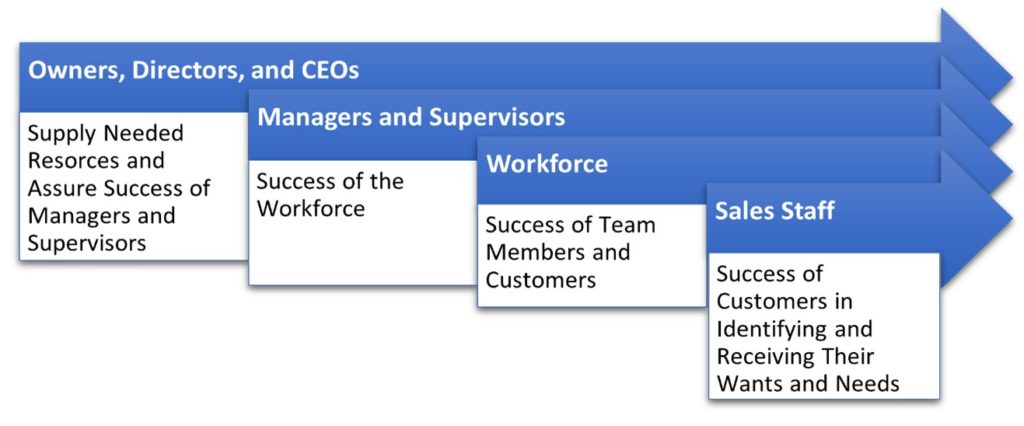Feb 4, 2021
“Not My Job” – The Prime Responsibility for Managers and Supervisors
John Tooley shares tips on responsibility and efficiency for managers and supervisors.
By: John Tooley

Abraham Lincoln said, “Always bear in mind that your own resolution to succeed is more important than any other.”
Cracking the code is to solve a difficult problem or mystery. The term is derived from interpreting coded intelligence during wartime and became current during World War II. The Navaho Indians “code talkers” gave us the code that played a great part in our victory. I will attempt to do the same with trying to crack the code of what our management and supervisor’s prime responsibility should be. When we require this of them, it will assure a greater harmony and success. All managers and supervisors have many responsibilities. However, I will focus on their primary focus.
I am sure we have written job descriptions for all to know what they are supposed to do. If we were to ask each to recite their job description many will state their perception of their job. The good and bad news is that perception drives our judgments and behavior. What happens if our perception is wrong? Could our business, customers and workforce suffer?
For several years, I have asked myself a few questions that might crack the code of what should be the prime responsibility of managers and supervisors. I have had to consider this from a systems viewpoint. I have questioned if there might be several questions that, if answered, would reveal an approach that might apply to all business. Is there a common purpose? Are there common attributes of desired outcomes, is there a common strategy, and is there a set of common tactics, that can guide our path to harmony and success? I believe my answer is yes to each question except one: purpose. Our purpose for why we do what we do is sure to vary.
I must start with a systems approach. For me, a system is a whole that derives its characteristics (behavior – good or bad) by the interactions of its essential parts and none taken separately. Production, administration, human relationships, finance, etc. are all parts of a business. Each is made up of desks, computers, file cabinets, tools, equipment, vehicles, etc. None of these physical pieces can cause healthy change. Only the people who make up the essential parts and their interactions can. Any one of the parts and its people are essential but not sufficient for healthy change. It is each part’s interaction with the other parts that drives the behavior. That is why Edwards Deming said, “If you don’t understand human behavior, you can’t understand business.” In his System of Profound Knowledge, he identified four important areas managers and supervisors must know and understand. The first was appreciation of a system. He also said understanding human behavior is a common need. I believe each have common answers that will crack the code of our prime responsibility towards our harmony and success.
I do not think our products, services, size of business, profit or nonprofit, or amount of available revenue restricts clarity and simplicity of our strategy, tactics, or purpose. Clarity and simplicity are the operative words. Let me define strategy and tactics as I see them and how they fit each of our businesses. We also should have our purpose clearly defined.
Common Wants
Common wants should drive our accountability for results. I think answering what we all want falls in three general areas. First, I am sure we would love to have less drama and less hassle in the workplace. Second, we all know that if we could reduce expense while not compromising quality, we would increase our profit. Third, adding wealth to our business while having less human effort would be welcomed by us all.
So now we face the question: To have these three things, what is the manager or supervisor’s prime responsibility? Let us look at the prime set of strategies that will fit every business.
Strategy
Let’s look at each member of a team and their general purpose.
- Owners, Directors, and CEOs: Keeper of the purpose, supplier of needed resources, and assure success of managers and supervisors.
- Managers and Supervisors: Their prime responsibility is to make our workforce successful.
- Workforce: Help team members be successful and customers successful through quality execution of our products or services.
- Salespersons: Make customers successful by identifying and assuring that they receive their wants and needs.

Meet Your New Boss: Success
Now, I ask you: What is the strategy or prime responsibility for our managers and supervisors? The answer: To make our workforce and sales staff successful. This is a strategy that meets our need for clarity and simplicity. If we make our workplace successful, who will also be successful? Answer: We will, no matter our size or vocation. If they are not successful, we are not doing our job.
Delivering success for all must become our mantra. To get a clear and simple answer of what makes our workforce successful, we will need clarity and simplicity in defining what tactics we will need to implement workforce success.
Before we begin tactics for workforce success, let us repeat a possible strategy for the workforce and then our sales staff. The workforce strategy should be to help make fellow team members successful, and customers successful through quality execution of our products or services. The sales strategy is to make customers successful in receiving first their wants and then needs while maintaining a safe and more healthy home. I am sorry to seem redundant, if each is successful with their strategy, who will be successful…we and our customers will be. This sounds like our prime responsibility is our product or service is SUCCESS. Relationship runs throughout our company. Everyone pursues work that aligns with their prime responsibility – SUCCESS OF OTHERS.
“The purpose of life is not the be happy. It is to be useful, to be honorable, to be compassionate, and to make some difference that you have lived and lived well.”
Ralph Waldo Emerson
Now, what are our tactics? They are an action or set of actions carefully planned to achieve a specific strategy.
The execution of our products or services is not the prime responsibility of the owner, director, CEO, or management. That is the prime responsibility of the workforce. Ours is to make them successful through our tactics. Tactics that will go a long way towards making our workforce successful fall into 6 areas.
- Make sure the workforce has all the resources needed to do their work.
- Create a culture that inspires intrinsic motivation of our workforce. A workplace that inspires is one that is safe, one that is free of the negative behaviors in the following table. The harmful impacts are not restricted to any one of the negative behaviors but often bleed across each.
- Let other’s intentions guide our relationships and discipline. Identify unintentional and intentional wrongdoing and appropriately deal with each. Process fails more than our people. The only time we blame people is when there is intentional wrongdoing, that alone is blame worthy. Unintentional wrongdoing is an accident, mistake, slip, or need for more training, etc. and is not blameworthy.
- Extend trust to our people. If we trust them, they will trust us.
- Assure a clear purpose, commit to mastery and extend autonomy.
- Communicate love (care for others), gratitude (the essence of receiving), and positive expectations every day in every way possible.
Purpose
To identify our prime responsibilities, we must also define our purpose: why we do what we do. We need to define why we do what we do because it defines what motivates us. It is important to think this over and again make it clear and simple, actionable, focused on the effect we will have on others, and expressed in positive language that resonates with you. When answering the following sentence, try to make what you do bigger than ourselves and transcendent. Many consider the reason for what they do is to make money. However, that should be the result of what you do. Let me give a couple examples.
We are dedicated to _____________________________so that ___________________.
We are dedicated to servicing and installing quality heating and cooling equipment so that our clients can better succeed in managing their indoor climate.
We are dedicated to improving the health, safety, durability, comfort, energy efficiency, and environmental responsibility of homes so that our clients may succeed at achieving superior living.
We are dedicated to helping the low income of our nation so that they can successfully realize a greater quality of life.
Our prime responsibility, no matter our position, is helping others succeed. This does not change all the tactics we employ every day to run our company. However, helping others succeed will deliver tactical success across our company. I am also persuaded that we should adopt purpose statements like ones above as guides for our successful future. As the success of our people goes, so goes our company. Accepting this challenge will allow us to live on beyond our lives.
When our strategy, tactics, and purpose have success as the central focus, less hassle, less expense, and less human effort will be our reality.




